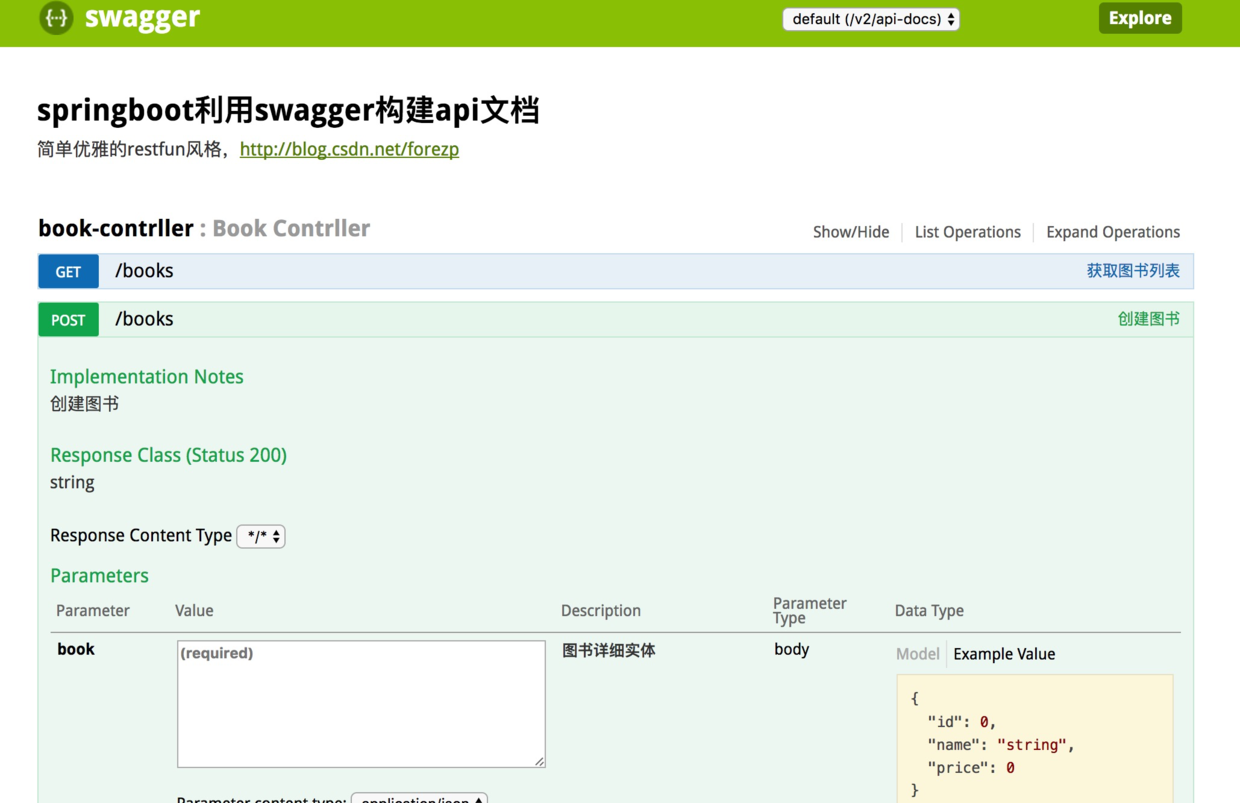声明:本部分内容均转自于方志明博友的博客,因为本人很喜欢他的博客,所以一直在学习,转载仅是记录和分享,若也有喜欢的人的话,可以去他的博客首页看:http://blog.csdn.net/forezp/article/details/71023536
swagger,中文“拽”的意思。它是一个功能强大的api框架,它的集成非常简单,不仅提供了在线文档的查阅,而且还提供了在线文档的测试。另外swagger很容易构建restful风格的api,简单优雅帅气,正如它的名字。
一、引入依赖
<dependency>
<groupId>io.springfox</groupId>
<artifactId>springfox-swagger2</artifactId>
<version>2.6.1</version>
</dependency>
<dependency>
<groupId>io.springfox</groupId>
<artifactId>springfox-swagger-ui</artifactId>
<version>2.6.1</version>
</dependency>
二、写配置类
@Configuration @EnableSwagger2 public class Swagger2 { @Bean public Docket createRestApi() { return new Docket(DocumentationType.SWAGGER_2) .apiInfo(apiInfo()) .select() .apis(RequestHandlerSelectors.basePackage("com.forezp.controller")) .paths(PathSelectors.any()) .build(); } private ApiInfo apiInfo() { return new ApiInfoBuilder() .title("springboot利用swagger构建api文档") .description("简单优雅的restfun风格,http://blog.csdn.net/forezp") .termsOfServiceUrl("http://blog.csdn.net/forezp") .version("1.0") .build(); } }
通过@Configuration注解,表明它是一个配置类,@EnableSwagger2开启swagger2。apiINfo()配置一些基本的信息。apis()指定扫描的包会生成文档。
三、写生成文档的注解
swagger通过注解表明该接口会生成文档,包括接口名、请求方法、参数、返回信息的等等。
(1)@Api:修饰整个类,描述Controller的作用
(2)@ApiOperation:描述一个类的一个方法,或者说一个接口
(3)@ApiParam:单个参数描述
(4)@ApiModel:用对象来接收参数
(5)@ApiProperty:用对象接收参数时,描述对象的一个字段
(6)@ApiResponse:HTTP响应其中1个描述
(7)@ApiResponses:HTTP响应整体描述
(8)@ApiIgnore:使用该注解忽略这个API
(9)@ApiError :发生错误返回的信息
(10)@ApiParamImplicitL:一个请求参数
(11)@ApiParamsImplicit: 多个请求参数
现在通过一个栗子来说明:
package com.forezp.controller; import com.forezp.entity.Book; import io.swagger.annotations.ApiImplicitParam; import io.swagger.annotations.ApiImplicitParams; import io.swagger.annotations.ApiOperation; import org.springframework.ui.ModelMap; import org.springframework.web.bind.annotation.*; import springfox.documentation.annotations.ApiIgnore; import java.util.*; /** * 用户创建某本图书 POST /books/ * 用户修改对某本图书 PUT /books/:id/ * 用户删除对某本图书 DELETE /books/:id/ * 用户获取所有的图书 GET /books * 用户获取某一图书 GET /Books/:id * Created by fangzhipeng on 2017/4/17. * 官方文档:http://swagger.io/docs/specification/api-host-and-base-path/ */ @RestController @RequestMapping(value = "/books") public class BookContrller { Map<Long, Book> books = Collections.synchronizedMap(new HashMap<Long, Book>()); @ApiOperation(value="获取图书列表", notes="获取图书列表") @RequestMapping(value={""}, method= RequestMethod.GET) public List<Book> getBook() { List<Book> book = new ArrayList<>(books.values()); return book; } @ApiOperation(value="创建图书", notes="创建图书") @ApiImplicitParam(name = "book", value = "图书详细实体", required = true, dataType = "Book") @RequestMapping(value="", method=RequestMethod.POST) public String postBook(@RequestBody Book book) { books.put(book.getId(), book); return "success"; }
@ApiOperation(value="获图书细信息", notes="根据url的id来获取详细信息") @ApiImplicitParam(name = "id", value = "ID", required = true, dataType = "Long",paramType = "path") @RequestMapping(value="/{id}", method=RequestMethod.GET) public Book getBook(@PathVariable Long id) { return books.get(id); } @ApiOperation(value="更新信息", notes="根据url的id来指定更新图书信息") @ApiImplicitParams({ @ApiImplicitParam(name = "id", value = "图书ID", required = true, dataType = "Long",paramType = "path"), @ApiImplicitParam(name = "book", value = "图书实体book", required = true, dataType = "Book") })
@RequestMapping(value="/{id}", method= RequestMethod.PUT) public String putUser(@PathVariable Long id, @RequestBody Book book) { Book book1 = books.get(id); book1.setName(book.getName()); book1.setPrice(book.getPrice()); books.put(id, book1); return "success"; }
@ApiOperation(value="删除图书", notes="根据url的id来指定删除图书") @ApiImplicitParam(name = "id", value = "图书ID", required = true, dataType = "Long",paramType = "path") @RequestMapping(value="/{id}", method=RequestMethod.DELETE) public String deleteUser(@PathVariable Long id) { books.remove(id); return "success"; } @ApiIgnore//使用该注解忽略这个API @RequestMapping(value = "/hi", method = RequestMethod.GET) public String jsonTest() { return " hi you!"; } }
通过相关注解,就可以让swagger2生成相应的文档。如果你不需要某接口生成文档,只需要在加@ApiIgnore注解即可。
需要说明的是,如果请求参数在url上,@ApiImplicitParam 上加paramType = “path” 。
启动工程,访问:http://localhost:8080/swagger-ui.html ,就看到swagger-ui:
